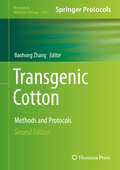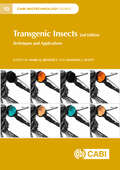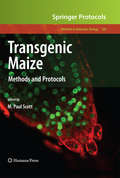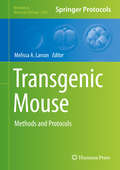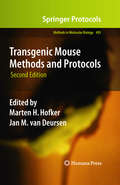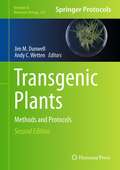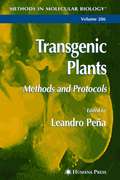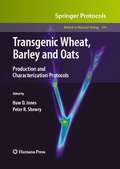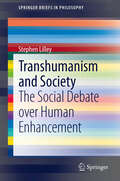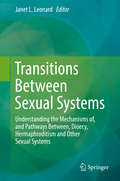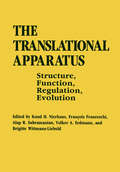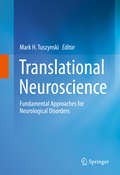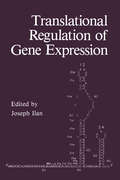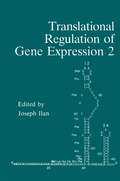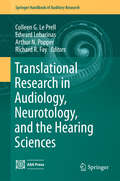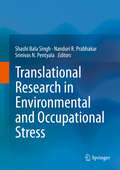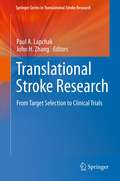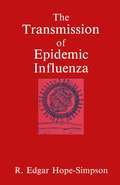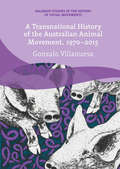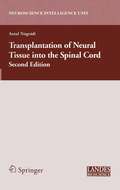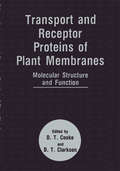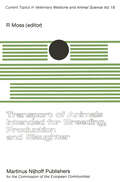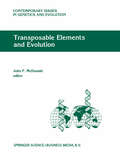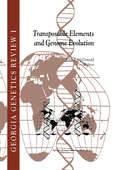- Table View
- List View
Transgenic Cotton: Methods and Protocols (Methods in Molecular Biology #1902)
by Baohong ZhangThis second edition provides a comprehensive collection of the cutting-edge methods for creating and monitoring transgenic cotton and its application on agricultural and basic research. Chapters detail current status and perspectives of transgenic cotton, principle and methods for making transgenic cotton, creating gene knockout lines, foreign gene copy and expression in transgenic plants, improvements to cotton using transgenic technology, and monitoring the potential impact of transgenic cotton on environment. Written in the highly successful Methods in Molecular Biology series format, chapters include introductions to their respective topics, lists of the necessary materials and reagents, step-by-step, readily reproducible laboratory protocols, and tips on troubleshooting and avoiding known pitfallsAuthoritative and cutting-edge, Transgenic Cotton: Methods and Protocols 2nd aims to be a resource for scientists as well as graduate students who work on transgenic plants, plant genetics, molecular biology, and agricultural sciences.
Transgenic Insects: Techniques and Applications (CABI Biotechnology Series #3)
by Hassan M. Ahmed Omar S. Akbar Serap Aksoy Yehonatan Alcalay Luke Alphey Yael Arien Rotem Daniel Avraham Camilla Beech Nicholas J. Bongio Vanessa Bottino-Rojas L. Roman Carrasco Lucy Carter Jackson Champer Isabelle Coche Carolina Concha Rocco D’Amato Brinda Dass Jason A. Delborne Ellen M. Dotson Ravi V. Durvasula Matthew P. Edgington Claudia Emerson Guido Favia Adam P. Forshaw Alexander W.E. Franz Marisa L. Guido Monika Gulia-Nuss Daniella An Haber Andrew Hammond Alfred M. Handler Keith R. Hayes Ivy Hurwitz Anthony A. James Thomas P. Kelly Nicole Klein Ana Kormos Lee Benjamin Lamdan David J. Lampe Rosemary S. Lees Maria Vittoria Mancini Aditi Mankad John Mumford Tony Nolan Andrew Nuss David A. O’Brochta Riccardo Papa Philippos Aris Papathanos Michael Pham Ricardo Pereira Megan Quinlan Robyn Raban Jason L. Rasgon Aaron Roberts Yasha Rohwer Nathan Rose Marc F. Schetelig Kristof De Schutter Hideki Sezutsu Arvind Sharma Gregory S. Simmons Guy Smagghe Toshiki Tamura Delphine Thizy Lea Pare Toe Brian L. Weiss Ernst A. Wimmer Liu YangTechnology for modifying the genotypes and phenotypes of insects and other arthropods has steadily progressed with the development of more precise and powerful methods, most prominently transgenic modification. For many insect pests, there is now almost unlimited ability to modify phenotypes to benefit human health and agriculture. Precise DNA modifications and gene drive have the power to make wild-type populations less harmful in ways that could never have been performed with previous transgenic approaches. This transition from primarily laboratory science to greater application for field use has also necessitated greater development of modeling, ethical considerations and regulatory oversight. The 2nd Edition of Transgenic Insects contains chapters contributed by experts in the field that cover technologies and applications that are now possible. This edition includes increased attention to associated challenges of risk assessment, regulation, and public engagement. Featuring: Up-to-date analysis of molecular techniques, such as gene editing. Consideration of public attitudes and regulatory aspects associated with transgenic insects. Many examples of the wide range of applications of transgenic insects. This book will be very valuable to students and researchers in entomology, molecular biology, genetics, public health and agriculture, and will also appeal to practitioners who are implementing the technology, and to regulators, stakeholders and ethicists.
Transgenic Maize: Methods and Protocols (Methods in Molecular Biology #526)
by M. Paul ScottAs increasing global population and continuing economic development ensure the need for further production and cultivation of maize, the necessity of the application of transgenic technology to this model species and crop plant grows steadily. In Transgenic Maize: Methods and Protocols, experts in the various disciplines of the field contribute readily reproducible protocols covering such topics as transformation methods, transgenic maize in research, the analysis of transgenic plants, and breeding with transgenes. Written in the highly successful Methods in Molecular Biology™ series format, the chapters present brief introductions to their respective topics, lists of the necessary materials and reagents, step-by-step laboratory protocols, and notes on troubleshooting and avoiding known pitfalls. Cutting-edge and easy to use, Transgenic Maize: Methods and Protocols will greatly aid researchers wishing to use these procedures in their own laboratories, and will provide readers with a better understanding of the experiments being performed by cooperators or fee-for-service labs.
Transgenic Mouse: Methods and Protocols (Methods in Molecular Biology #2066)
by Melissa A. LarsonThis volume provides readers with a historical foundation in standard techniques and a comprehensive update on the latest methods used in making gene-modified mice. The chapters in this book cover topics such as pronuclear microinjection in one-cell embryos; embryo transfer surgery; nuclear transfer and cloning; blastocyst microinjection; and cryobanking and recovery of genetically modified mice. Importantly, there are chapters devoted to the latest application of CRISPR technology, as well as the establishment of induced pluripotent stem cells. Written in the highly successful Methods in Molecular Biology series format, chapters include introductions to their respective topics, lists of the necessary materials and reagents, step-by-step, readily reproducible laboratory protocols, and tips on troubleshooting and avoiding known pitfalls.Comprehensive and authoritative, Transgenic Mouse: Methods and Protocols is a valuable resource for both novice and expert researchers who are interested in learning more about this evolving field.
Transgenic Mouse Methods and Protocols (Methods in Molecular Biology #693)
by Marten H. Hofker and Jan DeursenThe generation of genetically modified mice is absolutely crucial to gene function studies today, primarily because mice are genetically similar to man and because gene function studies in mice are in the context of a whole organism, making them particularly useful. In Transgenic Mouse Methods and Protocols, Second Edition, expert research explore current advances in the field through detailed laboratory protocols. Chapters provide a general introduction outlining how to deal with mice and how to generate transgenic mouse models, explore the generation of conditional and induced knockout and transgenic mice, and offer alternative routes to studying gene function in mice. Composed in the highly successful Methods in Molecular Biology™ series format, each chapter contains a brief introduction, step-by-step methods, a list of necessary materials, and a Notes section which shares tips on troubleshooting and avoiding known pitfalls. Comprehensive and state of the art, Transgenic Mouse Methods and Protocols, second Edition is the ideal guide for all researchers interested in the latest information about the production and analysis of transgenic and knockout mice.
Transgenic Plants: Methods and Protocols (Methods in Molecular Biology #847)
by Jim M. Dunwell and Andy C. WettenIn 2010 the global area of transgenic crops reached 148 million hectares, an 87-fold increase since 1996, making it the most rapidly adopted technology in the history of modern agriculture. In Transgenic Plants: Methods and Protocols, Second Edition expert researchers in the field provide key techniques to investigate production and analysis of transgenic plants. Focusing on selection and detection methods, transformation technology, gene targeting, silencing and directed mutation, metabolic engineering and pharming, the book encompasses protocols relating to major crops and model plants being used for genomic analysis. Written in the highly successful Methods in Molecular Biology™ series format, the chapters include the kind of detailed description and implementation advice that is crucial for getting optimal results in the laboratory. Thorough and intuitive, Transgenic Plants: Methods and Protocols, Second Edition aids scientists in the continuous improvements being made for the production and analysis of transgenic plants.
Transgenic Plants: Methods and Protocols (Methods in Molecular Biology #286)
by Leandro PeñaThe aim of Transgenic Plants: Methods and Protocols is to provide a source of information to guide the reader through a wide range of frequently used, broadly applicable, and easily reproducible techniques involved in the gene- tion of transgenic plants. Its step-by-step approach covers a series of methods for genetically transforming plant cells and tissues, and for recovering whole transgenic plants from them. The volume then moves on to the use of sele- able and reporter markers, positive selection, marker elimination after rec- ery of transgenic plants, and the analysis of transgene integration, expression, and localization in the plant genome. Although contributors usually refer to model plants in most chapters, the protocols described herein should be widely applicable to many plant species. The last two sections are devoted to me- ods of risk assessment and to exploring the current and future applications of transgenic technology in agriculture and its social implications in a case study. Transgenic Plants: Methods and Protocols is divided into six major s- tions plus an introduction, comprising 27 chapters. Part I, the Introduction, is a review of the past, present, and perspectives of the transgenic plants, from the discovery of Agrobacterium tumefaciens as a feasible transformation vector, to its use as a tool to study gene expression and function, and the current and possible future applications of this technology in agriculture, industry, and medicine.
Transgenic Wheat, Barley and Oats: Production and Characterization Protocols (Methods in Molecular Biology #478)
by Huw D. Jones and Peter R. ShewryUnderstanding the physical and genetic structure of cereal genomes and how defined coding and non-coding regions interact with the environment to determine a phenotype are key to the future of plant breeding and agriculture. The production and characteri- tion of transgenic plants is a powerful reverse genetic strategy increasingly used in cereals research to ascribe function to defined DNA sequences. However, the techniques and resources required to conduct these investigations have, until recently, been difficult to achieve or totally lacking in wheat, barley and oat. This book brings together the l- est protocols for the transformation, regeneration and selection using both biolistic and Agrobacterium tumefaciens appropriate for these three species. It includes two chapters describing in vitro Agrobacterium co-cultivation, one leading to germ line transformation with no need for tissue culture-based regeneration. In addition, it has several chapters dedicated to the manipulation of gene expression and characterisation of the recombinant locus and transgenic plants. Finally, it tackles the issues of GM risk assessment, field trials and substantial equivalence in terms of transcriptomics, proteomics and metabolomics. Although this book is dedicated to the temperate small grain cereals wheat, barley and oats, many of the techniques described could be readily adapted for other cereals or plants generally. We thank all the contributing authors for their timely and informative chapters, the staff of Humana Press, especially John Walker for their guidance, and Helen Jenkins for her proof-reading, word processing and administrative support. v Contents Preface . . . . . . . . . . . . . . . . . . . . . . . . . . . . . . . . . . . . . . . . . . . . . . . . . . . . . . . . . . . . . v Contributors. . . . . . . . . . . . . . . . . . . . . . . . . . . . . . . . . . . . . . . . . . . . . . . . . . . . . . . . . ix PART I.
Transhumanism and Society: The Social Debate over Human Enhancement (SpringerBriefs in Philosophy)
by Stephen LilleyThis book provides an introductory overview to the social debate over enhancement technologies with an overview of the transhumanists' call to bypass human nature and conservationists' argument in defense of it. The author present this controversy as it unfolds in the contest between transhumanists proponents and conservationists, who push back with an argument to conserve human nature and to ban enhancement technologies. This book provides an overview of the key contested points and present the debate in an orderly, constructive fashion. Readers are informed about the discussion over humanism, the tension between science and religion, and the interpretation of socio-technological revolutions; and are invited to make up their own mind about one of the most challenging topics concerning the social and ethical implications of technological advancements.
Transitions Between Sexual Systems: Understanding the Mechanisms of, and Pathways Between, Dioecy, Hermaphroditism and Other Sexual Systems
by Janet L. LeonardThis book focuses on explaining the distribution of sexual systems (simultaneous hermaphroditism, sequential hermaphroditism, environmental sex determination,dioecy, androdioecy, etc.) among taxa, which remains a major challenge in evolutionary biology. Although significant advances have been made for angiosperms, there is not yet a theory that predicts the sexual system for the majority of animal taxa, and other taxa of plants also remain poorly understood. The problem, particularly for animals, is that sexual systems can be very conservative, with whole phyla and classes being characterized by a single sexual system; for example essentially the whole phylum Platyhelminthes is simultaneously hermaphroditic, whereas the Insecta (Hexapoda) and the Tetrapoda among the vertebrates, are exclusively dioecious. Sex allocation theory on the other hand, suggests that sexual systems should be highly responsive to evolution, changing with population density, life span, patterns of resource availability, etc. The book provides an overview of the topic and then presents a series of chapters, each dealing with a taxon with substantial lability in sexual system in order to identify the factors associated with changes in sexual system in each case. By doing so, the authors reveal factors that have not been considered in formal theory but seem to have a major impact on transitions between sexual systems.This book appeals to a wide readership in fields from zoology and evolutionary biology to botany.
The Translational Apparatus: Structure, Function, Regulation, Evolution
by K. H. Nierhaus F. Franceschi Alap Subramanian Volker Alfred Erdmann Brigitte Wittmann-LieboldProceedings of an international conference held in Berlin, Germany, October 31-November 5, 1992
Translational Neuroscience: Fundamental Approaches for Neurological Disorders
by Mark H. TuszynskiTranslational Neuroscience offers a far-reaching and insightful series of perspectives on the effort to bring potentially revolutionary new classes of therapies to the clinic, thereby transforming the treatment of human nervous system disorders. Great advances in the fields of basic neuroscience, molecular biology, genomics, gene therapy, cell therapy, stem cell biology, information technology, neuro devices, rehabilitation and others over the last 20 years have generated unprecedented opportunities to treat heretofore untreatable disorders of the nervous system. This book provides a wide-ranging yet detailed sample of many of these efforts, together with the methods for pursuing clinical translation and assessing clinical outcomes. Among the topics covered are Alzheimer’s disease, Parkinson’s disease, stroke, multiple sclerosis, epilepsy, motor neuron disease, pain, inborn errors of metabolism, brain tumors, spinal cord injury, neuroprosthetics, rehabilitation and clinical trial design/consideration.Translational Neuroscience is aimed at basic neuroscientists, translational neuroscientists and clinicians who seek to gain a perspective on the nature and promise of translational therapies in the current era. Both students and established professionals will benefit from the content.
Translational Regulation of Gene Expression 2
by J. IlanThis book, which results from the dramatic increase in interest in the control mechanism employed in gene expression and the importance of the regulated proteins, presents new information not covered in Translational Regulation of Gene Expression, which was published in 1987. It is not a revision of the earlier book but, rather, an extension of that volume witl, special emphasis on mecha nIsm. As the reader will discover, there is enormous diversity in the systems employing genes for translational regulation in order to regulate the appearance of the final product-the protein. Thus, we find that important proteins such as protooncogenes, growth factors, stress proteins, cytokines, lymphokines, iron storage and iron-uptake proteins, and a panorama of prokaryotic proteins, as well as eukaryotic viral proteins, are translationally regulated. Since for some gene products the degree of control is greater by a few orders of magnitude than their transcription, we can state that for these genes, at least, the expression is translationall y controlled. Translational regulation of gene expression in eukaryotes has emerged in the last few years as a major research field. The present book describes mechanisms of translational regulation in bacteria, yeast, and eukaryotic viruses, as well as in eukaryotic genes. In this book we try to provide in-depth coverage by including important examples from each group rather than systematically including all additional systems not described in the previous volume.
Translational Research in Audiology, Neurotology, and the Hearing Sciences (Springer Handbook of Auditory Research #58)
by Colleen G. Le Prell Edward Lobarinas Arthur N. Popper Richard R. FayTranslational Research is the interface between basic science and human clinical application, including the entire process from animal studies to human clinical trials (phases I, II, and III). Translational Research moves promising basic science results from the laboratory to bedside application. Yet, this transition is often the least-defined, least-understood part of the research process. Most scientific training programs provide little or no systematic introduction to the issues, challenges, and obstacles that prevent effective research translation, even though these are the key steps that enable high-impact basic science to ultimately result in significant clinical advances that improve patient outcome. This volume will provide an overview of key issues in translation of research from “bedside to bench to bedside”, not only from the perspective of the key funding agencies, but also from the scientists and clinicians who are currently involved in the translational research process. It will attempt to offer insight into real-world experience with intellectual property and technology transfer activities that can help move auditory technologies ahead, as scientists and clinicians typically have little or no formal training in these areas. Translational Research in Audiology and the Hearing Sciences will be aimed at graduate students and postdoctoral investigators, as well as professionals and academics. It is intended to function as a high-profile and up-to-date reference work on Translational Research in the auditory sciences, emphasizing research programs in the traditional areas including drugs and devices, as well as less traditional, still emerging, areas such as sensorineural hearing loss, auditory processing disorder, cochlear implants and hearing aids, and tinnitus therapies.
Translational Research in Environmental and Occupational Stress
by Shashi Bala Singh Nanduri R. Prabhakar Srinivas N. PentyalaCutting edge technologies can propel a simple finding in basic science to a concept that can be of immense value to the society. While applying novel techniques to unravel the mysteries of biological processes, an offshoot of applied branch emerged. This field, which is now widely referred to as Translational Research utilizes basic science findings and translates these findings into innovative concepts for the benefit of mankind. This branch of science has evolved into a multidisciplinary juggernaut encompassing all known fields of science as varied as biomedicine, environment, law, economics, sociology, etc. With the ever increasing interest in this branch and the dreams and aspirations that this field can bring, basic science researchers are now taking a bold step into this new realm, merging different fields of knowledge to come up with novel inventions. This book "Translational research in environmental and occupational stress" provides and insight into the research that led to discoveries, inventions and development of novel technologies which will have a tremendous impact on the future of mankind.
Translational Stroke Research: From Target Selection to Clinical Trials (Springer Series in Translational Stroke Research)
by Paul A. Lapchak and John H. ZhangThis volume sets a basis for effective translational research. Authored by experts in the field of translational stroke research, each chapter specifically addresses one or more components of preclinical stroke research. The emphasis is placed on target identification and drug development using state-of-the-art in vitro and in vivo assays, in combination with in vitro toxicology assays, AMDE and clinical design.
The Transmission of Epidemic Influenza
by R.E. Hope-SimpsonTHE PLAGUE YEARS Mankind has always been fascinated by "origins," and biologists are no exception. Darwin is our most famous example. What is the origin of mankind, of species, of infectious diseases? In the last few years we have seen the emergence and spread of some apparently "new" viruses, such as HIV -1 and the virus causing bovine spongiform encephalomyelopathy. But are these, in fact, entirely new agents, or mutated forms of "old" viruses that have evolved along with us for eons? Edgar Hope-Simpson could not have written this book at a more opportune moment. He is a firm believer in gradual evolution, rather than the sudden arrival of new agents. I suspect that he would also have a naturalist's Darwinian approach for the origin of AIDS. It has been a source of some amazement to me over the years how even the most innovative scientists conform to a current hypothesis. Pioneer thinking comes more easily to persons outside the scientific mainstream. Edgar Hope Simpson has always struck me as a modem-day naturalist of the classic style, observant and perhaps a little maverick in line of thought. Certainly, the central hypothesis propounded in this book will be controversial to many scientists. From his unique citadel, the Epidemiological Research Unit in Cirencester, he has carefully reexamined mortality data from old records as well as new.
A Transnational History of the Australian Animal Movement, 1970-2015
by Gonzalo VillanuevaThis book offers the first transnational historical study of the creation, contention and consequences of the Australian animal movement. Largely inspired by Peter Singer and his 1975 book Animal Liberation, a new wave of animal activism emerged in Australia and across the world. In an effort to draw public and media attention to the plight of animals, such as the rearing of pigs and poultry in factory farms and the export of live animals to the Middle East and South East Asia, Australian activists were often innovative and provocative in how they made their claims. Through lobbying, disruptive methods, and vegan activism, the animal movement consistently contested the politics and culture of how animals were used and exploited. Australians not only observed and learnt from people and events overseas, but also played significant international roles. This book examines the complex and conflicting consequences of the animal movement for Australian politics, as well as its influence on broader social change.
A Transnational History of the Australian Animal Movement, 1970-2015
by Gonzalo VillanuevaThis book offers the first transnational historical study of the creation, contention and consequences of the Australian animal movement. Largely inspired by Peter Singer and his 1975 book Animal Liberation, a new wave of animal activism emerged in Australia and across the world. In an effort to draw public and media attention to the plight of animals, such as the rearing of pigs and poultry in factory farms and the export of live animals to the Middle East and South East Asia, Australian activists were often innovative and provocative in how they made their claims. Through lobbying, disruptive methods, and vegan activism, the animal movement consistently contested the politics and culture of how animals were used and exploited. Australians not only observed and learnt from people and events overseas, but also played significant international roles. This book examines the complex and conflicting consequences of the animal movement for Australian politics, as well as its influence on broader social change.
Transplantation of Neural Tissue into the Spinal Cord (Neuroscience Intelligence Unit)
by Antal NogradiThe book gives an account of results obtained from experiments where grafts of neuronal, glial and other tissues as well as artificial materials were placed into the spinal cord. It attempts to evaluate the contributions made by these studies to our understanding of basic neurobiologies questions. These include factors that regulate neuronal growth during development as well as regenera tion following injury to the nervous system. The model of neural transplanta tion is also useful for the study of cell-to-cell interactions, and this applies to interactions between glial cells and neurones, between various populations of neuronal cells and finally between axons and skeletal muscle fibres. The mecha nisms involved in the establishment of specific synaptic connections between neurones can also be investigated in this experimental paradigm. Important in formation regarding this issue was also obtained on systems other than the spinal cord, i. e. the cerebellum, hippocampus and striatum. Although such in formation of precise connections between the host and the grafted embryonic tissue is still lacking in the spinal cord, there is much information on the re sponse of the host nervous system to the grafted embryonic tissue, and that of the graft to its new host environment. It appears that embryonic grafts are able to induce repair processes follow ing injury to the nervous system.
Transport and Receptor Proteins of Plant Membranes: Molecular Structure and Function
by D. T. Clarkson D. T. CookeTransport of Animals Intended for Breeding, Production and Slaughter: A Seminar in the CEC Programme of Coordination of Research on Animal Welfare, organised by R. Moss, and held in Brussels, 7–8 July, 1981 (Current Topics in Veterinary Medicine #18)
by R. MossThe transport of farm livestock was the subject of the seminar held from 7 - 8 July 1981 at the Commission of the European Communities (CECl, Directorate General for Agriculture, Brussels as part of the work of the Division Coordinating Agricultural Research. The aims of the seminar were to examine the knowledge available on how the physiology and behaviour of animals may change during transport; to consider the significance of these changes in relation to welfare and economics and to assess those actions which as experimental projects or observational studies might be proposed to fill the most important gaps in our knowledge of the welfare of farm animals during transport. A number of conclusions can be drawn from the proceedings: 1. Much knowledge is available from both scientific observations and practical experience which could be used to improve the transport of livestock. Methods of loading, the construction of vehicles, ships, crates and aircraft could benefit from the application of existing knowledge. It is less clear whether it is best to concentrate on disseminating existing knowledge by education and advice or to contemplate more regulations. 2. Losses by down-grading at slaughter can largely be attributed to the ways in which animals are transported and handled.
Transposable Elements and Evolution (Contemporary Issues in Genetics and Evolution #1)
by J. F. McDonaldIn the summer of 1992 a distinguished group of molecular, population and evolutionary geneticists assembled on the campus of the University of Georgia in Athens, USA to discuss the relevance of their research to the role played by transposable elements (TEs) in evolution. The meeting consisted of a series of informal discussions of issues brought up in papers written by the participants and distributed among them prior to the meeting. These papers and the transcripts of the ensuing discussions are presented in this volume.
Transposable Elements and Genome Evolution (Georgia Genetics Review #1)
by J. F. McDonaldOnce considered merely `selfish' or `parasitic' DNA, transposable elements are today recognized as being of major biological significance. Not only are these elements a major source of mutation, they have contributed both directly and indirectly to the evolution of genome structure and function. On October 8-10, 1999, 100 molecular biologists and evolutionists representing 11 countries met on the campus of The University of Georgia in Athens for the inaugural Georgia Genetics Symposium. The topics of presentations ranged from how the elements themselves have evolved to the impact transposable elements have had on the evolution of their host genomes. The papers in this volume therefore represent state-of-the-art thinking, by leading world experts in the field, on the evolutionary significance of transposable elements.
